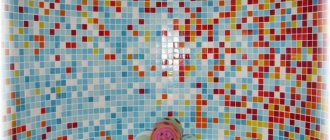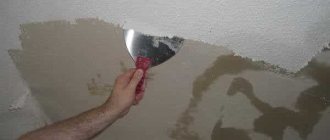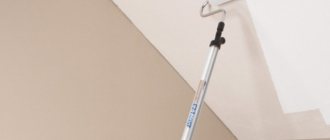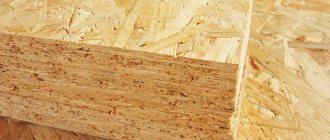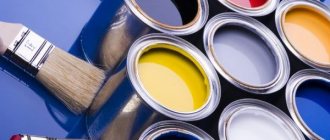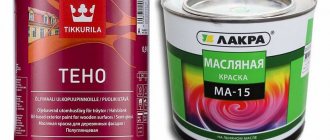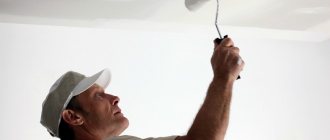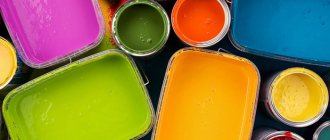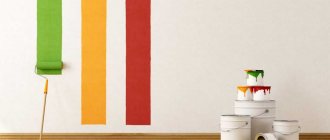Paper wallpaper is an attractive and affordable finishing material. But they tend to become unusable after a while, losing their external aesthetics, or simply become boring with their colors. And then you have a choice: replace this part of the interior or update it?
Changing the finish completely is quite expensive and time-consuming, but we will look at whether it is possible to paint old paper wallpaper and how to do it in this article.
Applying paint to the surface of old wallpaper
Vinyl painting
Synthetic vinyl material cannot be glued to a surface without a base. It can be paper or non-woven.
It is not recommended to paint vinyl roll material on a paper basis: neither new finishing material, nor old one that has been hanging on the wall for many years. The CM is impregnated in depth, the panel is stratified into vinyl and paper. After this it can slide down. The decision to apply paint is a risky one.
Vinyl on non-woven fabric is painted, but with due care for the nuances of the work . The difficulty with painting is that foamed vinyl repels any type of dye. To ensure that the paint lies evenly, the surface of the wallpaper is treated with a primer. The work is done carefully, not a single centimeter is missed. The first primer coat must dry. After 2 hours, a second coat of primer is applied. Accuracy and thoroughness do not decrease. If new panels are glued, then after gluing them at least 24 hours pass before they begin to be painted.
Before priming, the surface of the wallpaper is degreased, washed with dishwashing detergent, rinsed and dried. When the finishing material is dry, the strength of its adhesion to the wall is checked. If it holds, then it is covered with a primer. It makes no sense to check on a small section of the wall the possibility of painting old vinyl trim on a non-woven base. It may turn out that this is where the wallpaper holds especially tightly compared to the entire wall, and the correct test will not work.
Painting paper wallpaper
Of all the variety of finishing roll materials, especially paper ones are not recommended to be painted. They become wet, easily tear under the roller, and fall down from the weight of the CM. This is an inexpensive type that has been used for wall decoration for many years. Single-layer and two-layer coatings are produced. Duplex (two-layer) is more durable with an interesting relief pattern. But even they do not withstand staining well. The answer to the question is it possible to paint paper wallpaper - this is your risk.
Advice: all the sophistication will be lost if the wallpaper of elite types (textile, cork, bamboo) is repainted.
Selecting KM for each type of wallpaper
Craftsmen advise treating KM wallpaper without paint no more than 1-2 times. The composition of the dye is selected based on the type of wall finishing material:
- for non-woven coverings - a water-based acrylic composition is recommended;
- paint for paper wallpaper - latex CM has an advantage;
They are in demand due to their affordable price. They contain low-cost solvents, which makes them inexpensive.
Important: oil-based dyes slide off vinyl because they do not penetrate deep into such wall coverings. Therefore, they cannot be used categorically.
- A water-based emulsion is applied to the vinyl. If you purchase a basic white color, you can add a pigment of the desired color to the paint, which allows you to create an original interior. Using special acrylic compounds, patterns are applied to vinyl wallpaper using stencils. But if you want to show your imagination, then it is better to do it on vinyl wallpaper, which is intended for painting. Then it will be pleasure, not torment;
Advice: not only the aesthetic wishes of the owners are taken into account when choosing a room, but the purpose of the room also plays a role, its size, and the degree of illumination from a natural source. For example, in a large room, matte paint is applied; gloss or semi-gloss coating will visually enlarge a small room.
Any type of dye is chosen a tone darker than the finishing material on the wall, so that the shade of the rolled material is covered.
- If you still decide to paint paper wallpaper, then acrylic paints, water-based emulsion, latex, and alkyd-based CM are recommended.
Wallpaper glue
The work can be done efficiently and quickly if you purchase glue for the type of wallpaper.
Experts recommend:
- adhesive composition from the French company Kleo (for non-woven fabric the price is 867.00 rubles per 1 kg. A package of 260 grams is diluted with 6.0 liters of liquid glue, which is used to cover a 30 m2 area), the second option is Quelid (the price depends on the type of wallpaper. For non-woven wallpaper price 309.00 rubles per pack of 300.0 grams. Enough for gluing 4 rolls);
- CMC, proven over the years (price 50-200 rubles). If PVA is introduced into the composition, then the leadership of the mixture in terms of strength is undeniable.
Offers from manufacturers
The paint on the surface of the wallpaper not only serves as a decoration, but is also used as a protective layer. Therefore, the chemical composition of the CM, which is suitable for a certain type of surface, is taken into account.
Alkyd-based CM from brands is applied:
Water-based or latex dyes from leading manufacturers are used:
- Dulux, an international brand based in the UK;
- Beckers, Italy;
- Tikkurila, Finland.
Universal acrylic, which is applied to wallpaper, is marked on the container: “VD-AK”. A coating is formed on the surface that resists exposure to sunlight and can withstand cleaning using detergents.
Marking “VD-VA” means latex. Apply to textured and glass wallpaper. The composition has a special application technology. The coating resists exposure to water.
The table shows dyes often used by consumers. They have proven themselves to be a high-quality coating.
| Brand | Manufacturer country | Price, ruble |
| VGT interior snow-white moisture-resistant 1.5 kg, acrylic based | Russia | 585,00 |
| Tikkurila lumi for interior (waterproof) 9l, acrylate base | Finland | 7752,00 |
| Chief technologist 2.4 kg | Russia | 500,00 |
| Pufas Interior interior moisture resistant, w/d 10 l | Germany | 1150,00 |
| Dulux Diamond Matt / Dulux Diamond Matt Paint for walls and ceilings, water-dispersion matte, 1l |
Drawings and decoration
After the first layer of paint has dried, you can begin to decorate the ceiling or walls by creating certain applications, ornaments and designs on their surface.
This stage should be planned before the renovation and purchase of wallpaper begins. Indeed, today such finishing has a wide range of products, differing in texture, patterns and other characteristics.
When creating drawings with other types of paint, you can use a hard roller and wallpaper with a pronounced relief. Thus, you can paint your wallpaper with your own hands with water-based paint of a different color and get a beautiful and unusual design. In addition, to obtain certain artistic effects, you can use the following tools:
- brushes of different sizes;
- stencils;
- cotton swabs.
Related article: How to install folding doors (accordion, book)
Thanks to such tools, a person will be able to create even a complex floral ornament with his own hands.
Decor and designs are applied with dyes of other colors that contrast with the primary layer. It is desirable that the dye chosen in this situation has certain properties (for example, moisture resistance, mechanical resistance, etc.). For these purposes, there are a wide variety of special artistic compositions. But their cost is quite high. Therefore, they are usually used by professionals who have the necessary skills and knowledge.
If the paint does not have additional properties, after it has dried, the surface of the walls and ceiling can be varnished for a longer service life.
The key to successfully applying decor with water-based paint is correctly selected materials with compatible components. Using such materials, even a beginner can achieve excellent results and high quality of work done with their own hands.
Pros and cons of painting wallpaper
An objective analysis of all the positive and negative aspects of the process of applying paint to wall decor allows you to accept or reject the decision of this method of interior renovation.
- Almost all compositions can be tinted; it is possible to choose the desired shade for decoration. Colored CMs are selected to suit any style.
- The paint layer is not afraid of wet cleaning, so it is easy to keep the surface clean.
- Small stains in the form of stains or children's drawings can be easily removed by painting over these areas on the wall. A fragment of the required wallpaper is not selected or the entire wall is not re-glued.
- Painting as a technological process is much simpler than wallpapering.
- Various wall configurations (arches, corners) in a room are easy to paint.
- The work will be done perfectly if the surface has been well prepared.
- The result largely depends on the correctly selected paint and tools for painting work.
- KM for wallpaper does not repel dust well.
- On the surface of the wallpaper, the dye is a protective layer from minor mechanical damage, but a powerful blow breaks its integrity, which will be difficult to restore.
Determining the type of old paint composition
Before gluing the paper web, you should make sure that it will stick. The adhesion of the sheet to the wall directly depends on how and with what the walls were painted.
There are two main types of interior paint that are most often used in residential areas - oil and acrylic.
Oil-based paints have a more shiny finish and the applied layer is dense. Fresh material emits a strong, pungent odor. A simple test will help identify the presence of oily substances: you need to lightly pick up a piece of paint with the sharp corner of a spatula. This variety is distinguished by the fact that the paint will come off in large pieces or even layers.
Oily base
Water-based emulsion is otherwise called acrylic paint. This type of finishing is very problematic to remove from the wall, since it will not be possible to clean it; you will have to wash off the painted layer and wait until the working surface dries completely. But significant advantages include the absence of a sharp, unpleasant odor, as well as good adhesion and durability.
Before gluing wallpaper to walls painted with any type of paint, it is recommended to carefully prepare them: remove the old coating, clean it, and level it. But this is not always required. If the wall is fairly smooth and the paint on it is of high quality, then there is no obstacle to simply gluing the canvases to the existing base.
